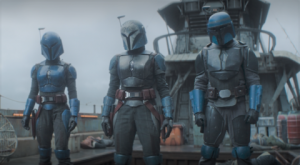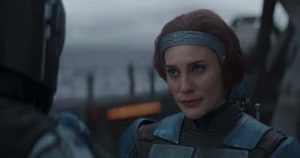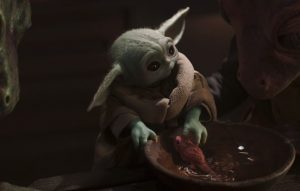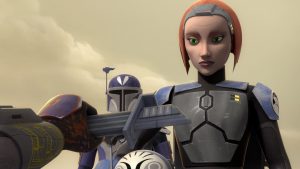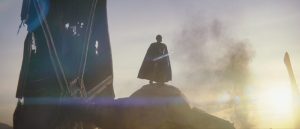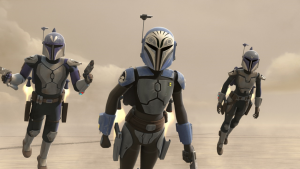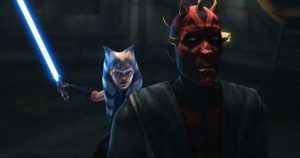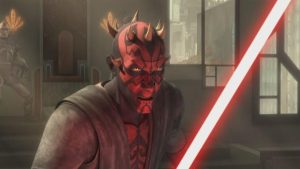SPOILERS FOR THE MANDALORIAN AHEAD!
How The Mandalorian‘s second season finale will be judged largely depends on what happens next, in either the sequel season it sets up with a not-so-subtle cliffhanger ending, or the spinoff it teases in an unexpected post-credits scene (or…are they are one and the same?), because what we got is very clearly not the resolution to a self-contained original story, but rather the prologue to a wider saga spanning the Star Wars universe. But right now, for this one blissful moment, my feelings are deeply conflicted yet generally positive…because you simply can’t do what The Mandalorian season two finale did in its closing minutes, and not excite the Star Wars fan in me.

Just as in season one, when Din Djarin (voiced and played by Pedro Pascal) had to assemble a team to defeat the unnamed Imperial client on Nevarro (the true identity of whom will likely remain one of the series’ many minor, irritating, unsolved mysteries), this season’s finale revolves around assembling a small gang of heavily-armed misfits and saving Baby Yoda – or Grogu, or The Child, or whatever you want to call him. Djarin had already gained the allegiances of Boba Fett (Temuera Morrison), Fennec Shand (Ming-Na Wen), and Cara Dune (Gina Carano). The last piece in the puzzle is the Mandalorian princess Bo-Katan Kryze (Katee Sackhoff), who plays a pivotal role in the events of the finale, even though…well, it’s complicated, in a weird and somewhat unsatisfying way.
It’s nothing, however, compared to the intricacies of Mandalorian societal structures, which continue to grow increasingly messier the more we learn about them – today culminating in a face-off between Bo-Katan and Boba Fett where the two are barely able to resist from killing each other on the spot. The reasoning for that goes back a long way, to the animated Clone Wars series, in which it was revealed that most Mandalorians regard the entire House of Fett as outsiders to their creed and community – and Boba specifically as something entirely alien, due to the bounty hunter having been created inorganically as an identical clone of his father, Jango. Bo-Katan, who cast stones at Din Djarin for unknowingly belonging to a group of religious fanatics, now taunts Boba Fett with questions about his “donor”, and comparing him to other clones she’s known (and yes, that’s extremely hypocritical and uncharacteristic of her, since clone armies were instrumental in putting her in power after the Siege of Mandalore), causing a scuffle between Fett and Bo-Katan’s second-in-command, Koska Reeves (Sasha Banks). Fett, in turn, is utterly dismissive of Bo-Katan’s goal to unite the Mandalorian clans behind her and retake their ancestral home planet of Mandalore, which the Empire supposedly desecrated. In the end, the promise of finally being able to confront Moff Gideon (Giancarlo Esposito) and win back the Darksaber is what convinces Bo-Katan to join: though Din Djarin valiantly tries the “they-took-the-Child” route with her. It’s worked for everyone else, and it seems to be almost be enough for Bo-Katan, but the show is painting her as a low-key antagonist to Djarin for whatever reason, so they can’t have her be too kindhearted.
This is one of two instances in The Mandalorian so far (the other being Ahsoka’s refusal to train Grogu because of attachments) that I would be tempted to classify as character assassination if the term hadn’t been hijacked by trolls who use it broadly to mean anything that ever happened in the sequel trilogy. There’s a difference between character assassination and character development that a lot of people don’t get: and Luke Skywalker’s journey in The Last Jedi, for example, is a textbook example of the latter. Character development is organic and typically serves a thematic purpose; whereas assassination is a shortcut used lazily to rush the story forward (in Ahsoka’s case), or to force a conflict where there was none (in Bo-Katan’s case). What’s particularly frustrating is that audiences who don’t know Bo-Katan from the animated series’ will now remember her best as the borderline ruthless, prejudiced, ambitious-to-a-fault schemer she is here.
Laying out an elaborate strategy for how to infiltrate Gideon’s star-cruiser, the gang sets out in a small Imperial shuttle stolen from its previous pilot (played by Thomas Sullivan, whom I immediately recognized from Agents Of S.H.I.E.L.D.). The Mandalorian somehow has time to flesh out his character, and give him a pointless back-and-forth with Cara Dune, where he manipulates what I guess are supposed to be her traumatic memories of the destruction of Alderaan. The event has now been referenced twice this season, and, leaving aside the fact that Carano’s acting does nothing to convey the trauma of its aftermath (the dialogue literally mentions her shedding a tear, while Carano’s eyes are dry), it’s honestly just weird that people keep bringing it up in-universe.
Omid Abtahi briefly reprises the role of Dr. Pershing, the other occupant of the stolen shuttle, but there’s no time to interrogate him about Grogu’s exact midi-chlorian count. The fact that he was on his way to and not from Gideon’s cruiser bodes well for Grogu, as it implies he may not have had a chance to extract any further samples from the child (Gideon later confirms he’s taken his own samples of the child’s blood, but, well, that will be insignificant in the long run).
Director Peyton Reed is at his best while orchestrating the high-stakes, action-packed break-in – a stark contrast to his Ant-Man movies, which have mostly been low-stakes, filled with comedic action scenes and sight gags. Between this and the exhilarating spider chase he directed earlier in The Mandalorian‘s second season, he’s definitely given himself an upgrade before his next Marvel film, Ant-Man And The Wasp: Quantumania. His exceptional use of each character’s individual strengths makes for a very memorable string of fight scenes, and there’s a real sense of urgency and danger, even though most of our heroes are encased in beskar steel, which is nigh on impossible to shatter, dent, or damage in any way.

Din Djarin finds this out the hard way when he singlehandedly takes on Gideon’s elite platoon of robotic dark troopers – even with one of these super-sized metal juggernauts repeatedly hammering his face backwards into a wall with the force of a small battering ram, it’s the wall that gets broken to bits and Djarin who escapes unscathed, thanks to his beskar steel helmet. Hilariously, he’s then able to temporarily eliminate the dark trooper threat by blasting them all out an airlock.
While Bo-Katan and her all-female team storm the ship’s bridge looking for Gideon, Djarin accidentally but predictably encounters the Moff personally guarding his most prized possession, Grogu, with the Darksaber in hand. Finally, we can see why Lucasfilm hired Giancarlo Esposito for this role, as the ex-Imperial sneakily manipulates the conversation, feigning disinterest in the Mandalorian political situation while freely offering the child to Djarin. Although Djarin initially buys into his lies, it takes all of five seconds for Gideon to reveal his true colors and start hacking ferociously at Djarin with the Darksaber. The beskar steel gifted by Ahsoka Tano finally comes in handy, allowing Djarin the means to fight back in one of the series’ most hyped-up duels. The whole sequence is over suspiciously quickly, however, and Gideon is soon captured and dragged up to the bridge after being disarmed by Djarin.
When they reach the bridge, we find out just how cunning Gideon has been – possibly at the expense of established Star Wars canon. It was revealed a while ago in Rebels that, to wield the Darksaber and claim it as one’s own, one must first defeat the previous owner in combat. Or, at least, that was the case until Sabine Wren yielded the Darksaber willingly to Bo-Katan…who soon after lost it to Gideon himself, and spent years hunting him down, trying to make up for her failure and render her claim to the sword irrefutable. Gideon, by intentionally losing to Djarin, has now created a situation where Bo-Katan “can’t” take the sword unless she wins it in combat…from Din Djarin. Except she can. Sabine Wren set the precedent. Djarin offers it to her several times, only for Gideon to interject each time with a gleeful reminder of how Mandalorian law supposedly works. My best guess is that Bo-Katan blames her willingness to defy tradition and take the sword freely for all her failures, and for that reason won’t do so again. This whole thing is weirdly reminiscent of the Elder Wand debacle in Harry Potter.
It’s at this moment that the dark troopers return, flooding back onto the ship and charging towards the bridge, all while Gideon gleefully torments his captors with quips and boasts. His menace is rather undercut, though, by the sheer stupidity that compels him to grab a blaster and aim for Bo-Katan, who, reminder, is wearing beskar steel. He gets knocked unconscious by Cara Dune, and that’s literally the last we hear of him. A humiliating defeat for a villain that had just come into his own.
In the chaos, a single X-Wing fighter appears out of nowhere, heading for the cruiser. At first, I assumed it had to be the New Republic, come to save the day and convince us that a Rangers Of The New Republic spinoff series is actually necessary, but once the ship is confirmed to be flying solo and lands without communicating with the bridge, I figured I knew who its occupant had to be. Reed draws out the big reveal, forcing you to agonize and wrestle with your emotions and your “this can’t be happening” impulses, even as all the visual clues add up. And the brutal, beautiful suspense makes it that much more conflicting when the smoke clears, each and every dark trooper has been obliterated, and the person standing there is indeed Luke Skywalker (Mark Hamill)…but is also very much not.
The CGI replacement for young Luke – which uses Hamill’s digitally de-aged voice and likeness – is perhaps not quite as unnerving as the CGI Princess Leia in Rogue One, but nowhere near the seamless, stately elegance of CGI Tarkin in the same film. CGI Luke’s eyes are haunting and slightly unfocused, and his voice doesn’t quite seem to match the movement of his lips. He is, of course, revealed to be the Jedi that Grogu contacted back on Tython, but when they meet at last, Grogu waddles over immediately – only to spend most of the scene talking to Luke’s sidekick, R2-D2, in an excited chirping language matching the droid’s beeps, boops, and bops, while CGI Luke stands to the side; his ghastly top half purposefully out of frame, his lower half standing too still, like a background character in an animated movie.

Disturbing digital effects aside, the Luke reveal is emotional and brilliantly executed, and it makes sense that he’ll be the one to train Grogu in the ways of the Force. But of course saying goodbye is hard: and so Djarin removes his helmet willingly, revealing his face to Grogu for the first (and hopefully not last) time. The puppet’s tiny claw reaches out to touch Djarin’s cheek, wide eyes take in every feature of his face…and yes, those muffled sobs you hear are mine. What can I say? I love character development.
And with that, CGI Luke sweeps Baby Yoda into his Ken doll arms, and takes off, concluding the second season of The Mandalorian. So much is still unresolved! Moff Gideon is defeated, Din Djarin commands the Darksaber and must now either embrace a new destiny or pass it on to Bo-Katan, and Grogu is headed to Ach-To, I guess. Oh yeah, and Boba Fett and Fennec Shand are getting a spinoff (or maybe just taking over The Mandalorian), which we’ll discuss in greater detail, in the second half of my finale review.
Because this show is so frustrating, one just wasn’t enough.
Episode Rating: 7.5/10
